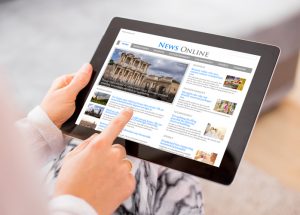Two-thirds of American students end up leaving school unprepared for college or a career, according to the 2016 Nation’s Report Card.[1] With the rising pressure to improve student outcomes, K-12 educators are turning to a number of new instructional technologies and models to personalize and enrich classroom learning. Read about four key trends that are accelerating the integration of new technologies in the classroom.
Online Learning
There are many reasons for high schools and colleges to create ad hoc online courses and programs. In some cases, educators have chosen to experiment with this format simply to gather better analytics with online tools that could better inform future course development. However, teachers and faculty still have some skepticism about the value of fully online courses and programs, and choose to apply similar practices and online tools in combination to traditional instruction, by way of blended learning and personalized learning.
Blended Learning
What does a blended learning model look like today? Blended learning is a formal education program, also known as hybrid or mixed-mode education, where a portion of traditional face-to-face instruction is replaced with online learning. The use of technology-powered blended learning offers a cost-effective approach to help students accelerate their learning and graduate, and can designed in many ways. The most common type is the rotation model, in which students rotate on a fixed schedule among learning modules that mix traditional and digital practices – online learning, small-group instruction, and pencil-and-paper tasks. With a flexible model, online learning is the main structure, and the teacher is on site to provide minimal face-to-face support (as needed for individual tutoring or small group projects).
The Flipped Classroom
In the traditional model of instruction, the teacher is at the center of the course and the primary distributor of information. The teacher controls the flow of discussion, and student engagement becomes limited to working alone or in a small group. A flipped classroom is a type of blended learning environment that seeks to put the student at the center, flipping the typical lecture and homework elements. Instead of devoting the class time to delivering the lecture, a teacher assigns short video lectures prior to the class session, so the time is used for discussion, homework, and projects. Many schools that have flipped their classrooms have seen tremendous results, particularly with math and science. In one example, Clintondale High School was able to increase their graduation rate while decreasing classroom failure rates by 33 percent within one year. [2]
Competency-Based Learning
This classroom strategy is creating more flexibility for students, allowing them to progress through a course as they demonstrate mastery of the academic content – transitioning away from a structure that depends on seat time, so students learn entirely at their own pace. This type of learning is highly personalized to the student’s learning process and can include some online and blended learning elements. The Big Picture Learning School created their own competency-based learning model that encourages the student to take ownership of their own education. In it, a student works with an advisor and their parents to design an individual learning plan that fits their needs and interests. Under Ohio’s Credit Flexibility Plan, students can demonstrate competency by a combination of subject area competency and alternative experiences such as an internship, online course, community service, or independent study.[3]
References:
[1] Camera, Lauren. “High School Seniors Aren’t College-Ready,” U.S. News & World Report, 27 Apr 2016. Link
[2] Green, Greg. “My View: Flipped Classrooms Give Every Student a Chance to Succeed,” CNN Schools of Thought Blog, 18 Jan 2012. Link
[3] U.S. Department of Education. “Competency-Based Learning,” 2016. Link
